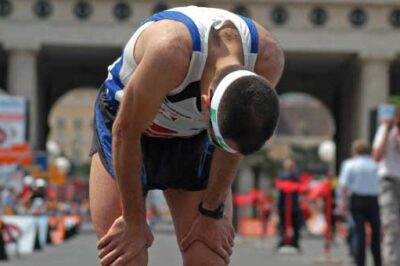You’ve heard it said that too much of a good thing isn’t a good thing. (Or something similar.) Exercise, it turns out, is no exception. In fact, it’s becoming increasingly clear that too much exercise, particularly long bouts of cardio, can do more harm than good.
This topic of discussion has been on my mind lately as I’ve driven around San Antonio, Texas, and noticed more and more cars bearing “13.1” and “26.2” bumper stickers. While I certainly have tremendous respect for those who are able to motivate and push themselves to train for and complete grueling long-distance races, I also harbor concern stemming from research showing that such exercise can put extraordinary stress on the heart.
According to a study presented at the Canadian Cardiovascular Congress 2010 in Montreal, Canada, extended vigorous exercises performed during a marathon raises cardiac risk by sevenfold! In addition, long-distance running also leads to a high level of inflammation that could trigger cardiac events and cause heart damage that lasts well after the end of the marathon.
In a recent study, researchers recruited a group of exceptionally fit older men, all of whom were part of the 100 Marathon Club, meaning they’d each completed a minimum of 100 marathons. The study found that half of the older lifelong athletes showed some heart scarring; incidentally, these were the men who had trained the longest and the hardest.
Another study showed that long-term endurance athletes suffer from diminished function of the right ventricle of the heart after endurance racing. They also had increased blood levels of cardiac enzymes, which are markers for heart injury. Twelve percent of the athletes had detectable scar tissue on their heart muscle one week after their race.
I share this information in hopes of speaking primarily to two groups of people: those who frequently participate in half and full marathons, and the 60 percent of Americans who don’t get the recommended 150 minutes of moderate to vigorous physical activity every week.
For any marathoners reading, I pray that you will take this knowledge into consideration as you prep for your next event. Perhaps you can limit the number of races you run each year and reduce the duration of your training sessions. Challenge yourself to find other forms of exercise to keep you busy and fit during your off-season.
For those whose hearts begin to hurt (from anxiety, mostly) just thinking about exercise, I pray that you will be heartened (pun intended) by the fact that less exercise is—you guessed it—more! There is absolutely no need to force yourself to spend the slowest hour of your day plodding along on a treadmill. In fact, a growing body of research shows that short bursts of high-intensity exercise may be more beneficial than long workouts.
One of my favorite methods of training, called HIIT (high-intensity interval training) requires just a few minutes of your day—you just have to be willing to give those minutes your all! HIIT consists of continuous bouts of high- and low-intensity exercise performed for a set amount of time, usually no more than 20 minutes. After a four- to five-minute warm-up, a HIIT workout might alternate 30-second sprints of cycling, rowing or running with one minute at a slower recovery pace. The 30-second time period is called an interval and could be repeated 10 times to compose an effective and efficient 15-minute workout.
A similar training philosophy is seen in workouts such as CrossFit WODs (“workout of the day”) in which participants not only run, row or cycle fast, but also jump, throw, press, pull and lift fast too. Many CrossFit WODs last no longer than 15 minutes, and by the end, you will have exerted more energy completing a high-intensity, total-body workout than most do during an hour at the gym meandering from machine to machine.
So, whether your thing is running for miles, bench-pressing seven days a week, doing Pilates or, perhaps, doing nothing, remember that God has designed our bodies to do it all: to run, swim, lift, squat, stretch and, yes, rest! Don’t let yourself become defined by any one activity or fearful that anything else will hurt you. Step out of your comfort zone and explore new sports and activities. You may be surprised by how refreshing and how great for the heart it can be.
Diana Anderson-Tyler is the author of Creation House’s Fit for Faith: A Christian Woman’s Guide to Total Fitness and her latest book, Perfect Fit: Weekly Wisdom and Workouts for Women of Faith and Fitness. Her popular website can be found at dianafit.com, and she is the owner and a coach at CrossFit 925. Diana can be reached on Twitter.
For the original article, visit dianaandersontyler.com.








Leave a Comment
You must be logged in to post a comment.